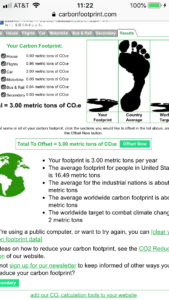
In a recent post I mentioned my intentions to offset my travel footprint, which was unusually high (for me) over the past couple of years. I flew in airplanes for the first time since 2010, and I took three solo car trips (by rental vehicle) to Virginia. Ordinarily these days, I avoid flying and solo long-distance car travel. (I don’t own a car and rarely accept rides even locally unless someone is already going my way.) However, all of the trips I mention above were in connection to family circumstances, and I would not have been willing to forgo them. So I decided I would purchase carbon offsets.
In his blog post “Taking Responsibility for My Flights,” Rob Greenfield mentions that he aims for the “Gold Standard” of carbon offset projects, which is the highest standard on the market. So I figured I’d do that too. I searched around, and the website I liked best was carbonfootprint.com, which allowed me to first calculate the impact of my travel, and then purchase carbon offsets on the same site. (The number you see in the graphic above represents two years’ worth of my travel.)
You can check out the calculator at www.carbonfootprint.com
This calculator is really handy because it allows you to set a time period, such as a year. And you can input each separate type of transportation: plane, personal car, bus, taxi, and so on. (You can also use the calculator to compute the carbon footprint of your household energy use and miscellaneous activities.) Although I set the time period to a year, I input all my travel for a two-year period, so the graphic above actually shows two years’ worth of my travel.
Another thing I like about the carbon footprint calculator I found is the crisp, easy-to-understand graphic that displays your “footprint” in relation to the U.S. average and the worldwide target.
I padded the numbers on the generous side to be more confident that I was doing enough. Also, I chose the most rigorous standard of offset projects, the Gold Standard recommended by Rob Greenfield. So how much did it cost me to offset my two-year period of extraordinarily high travel volume? About $31!
Some things I noticed: Although air travel is supposed to be the worst form of travel, environmentally speaking, I noticed that my approximately 4,000 miles of air travel had a lower footprint than my approximately 7,000 miles of car travel over the two-year period. Almost all my car travel was long-distance, but I did accept some rides locally and use taxis/Uber a couple of times. (I padded my estimate to cover that mileage with plenty to spare in case there was a ride or two I forgot.) Car ownership has a high footprint, because there is always the temptation to use that vehicle that sits in your driveway. By not owning a car, I end up naturally having a much lower footprint than average, without even trying that hard. I do end up forgoing some activities when the weather is cold or rainy. Then again, if I really want to do something, I will tough it out and get on the bicycle or bus.
Rob writes that he spent about $2,000 to offset around 199,000 miles of air travel. I was offsetting about 4,000 miles of air travel and 7,000 miles of car travel.
Give the Carbon Footprint calculator a try! And let me know how it goes for you.
